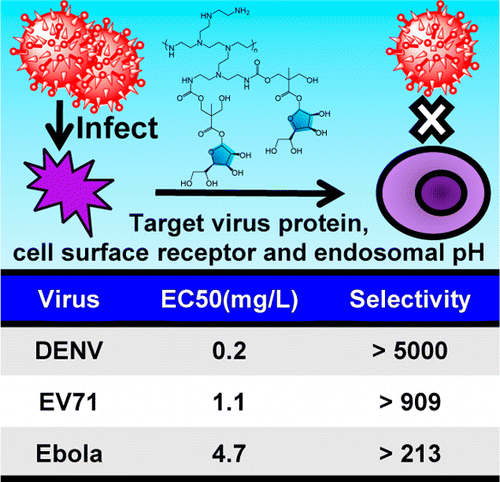Toward a resistance-proof antiviral that can treat many diseases

Scientists and health officials are marshalling forces to fight Zika, the latest in a string of recent outbreaks. Many of these efforts target that virus specifically, but some researchers are looking for a broader approach. Now one team reports in ACS' journal Macromolecules a new strategy to fight a wide range of viruses that appears to be safe in vivo and could evade a virus's ability to develop resistance.
Viruses are wily foes. They come in different forms, mutate rapidly and develop resistance to drugs easily. To fight them, scientists have largely attempted to tackle them one by one. But there are still no treatments for many viral infections, such as dengue and Ebola, even though some have been around for decades. A new approach aims to act more broadly against multiple viruses and involves targeting both viral surfaces and human cells. This strategy could also stop the pathogens in a way that could avoid the development of resistance. But so far, these methods have been toxic to healthy mammalian cells. Yi Yan Yang, Naoki Yamamoto, James Hedrick and colleagues wanted to find a safer method.
The researchers started with a polymer, called polyethylenimine (PEI), that had prevented viral infection through electrostatic interactions in previous studies. The PEI in those studies, however, was toxic to cells. So Yang and her collaborators modified it with mannose, a kind of sugar. The resulting complex interacted with the surfaces of both viral and human cells, and thus blocked the viruses from infecting the cells in lab testing. The researchers say this interaction can happen regardless of mutations and would make it difficult for a pathogen to sidestep. After two weeks of testing in an animal model, the modified PEI showed no toxic effects.
More information: Koji Ichiyama et al. Cooperative Orthogonal Macromolecular Assemblies with Broad Spectrum Antiviral Activity, High Selectivity, and Resistance Mitigation, Macromolecules (2016). DOI: 10.1021/acs.macromol.6b00091
Abstract
Treatment of viral infections continues to be elusive owing to the variance in virus structure (RNA, DNA, and enveloped and nonenveloped viruses) together with their ability to rapidly mutate and garner resistance. Here we report a general strategy to prevent viral infection using multifunctional macromolecules that were designed to have mannose moieties that compete with viruses for immune cells, and basic amine groups that block viral entry through electrostatic interactions and prevent viral replication by neutralizing the endosomal pH. We showed that cells treated with the antiviral polymers inhibited TIM receptors from trafficking virus, likely from electrostatic and hydrogen-bonding interactions, with EC50 values ranging from 2.6 to 6.8 mg/L, depending on the type of TIM receptors. Molecular docking computations revealed an unexpected, and general, specific hydrogen-bonding interactions with viral surface proteins, and virus and cell binding assay demonstrated a significant reduction in infection after incubating virus or cells with the antiviral polymers. Moreover, the mannose-functionalized macromolecules effectively prevented the virus from infecting the immune cells. Representative viruses from each category including dengue, influenza, Chikungunya, Enterovirus 71, Ebola, Marburg, and herpes simplex were surveyed, and viral infection was effectively prevented at polymer concentrations as low as 0.2 mg/L with very high selectivity (>5000) over mammalian cells. The generality of these cooperative orthogonal interactions (electrostatic and hydrogen-bonding) provides broad-spectrum antiviral activity. As the antiviral mechanism is based on nonspecific supramolecular interactions between the amino acid residues and mannose/cationic moieties of the macromolecule, the ability to form the virus–polymer and polymer−cell assemblies can occur regardless of viral mutation, preventing drug resistance development.
Provided by American Chemical Society


















